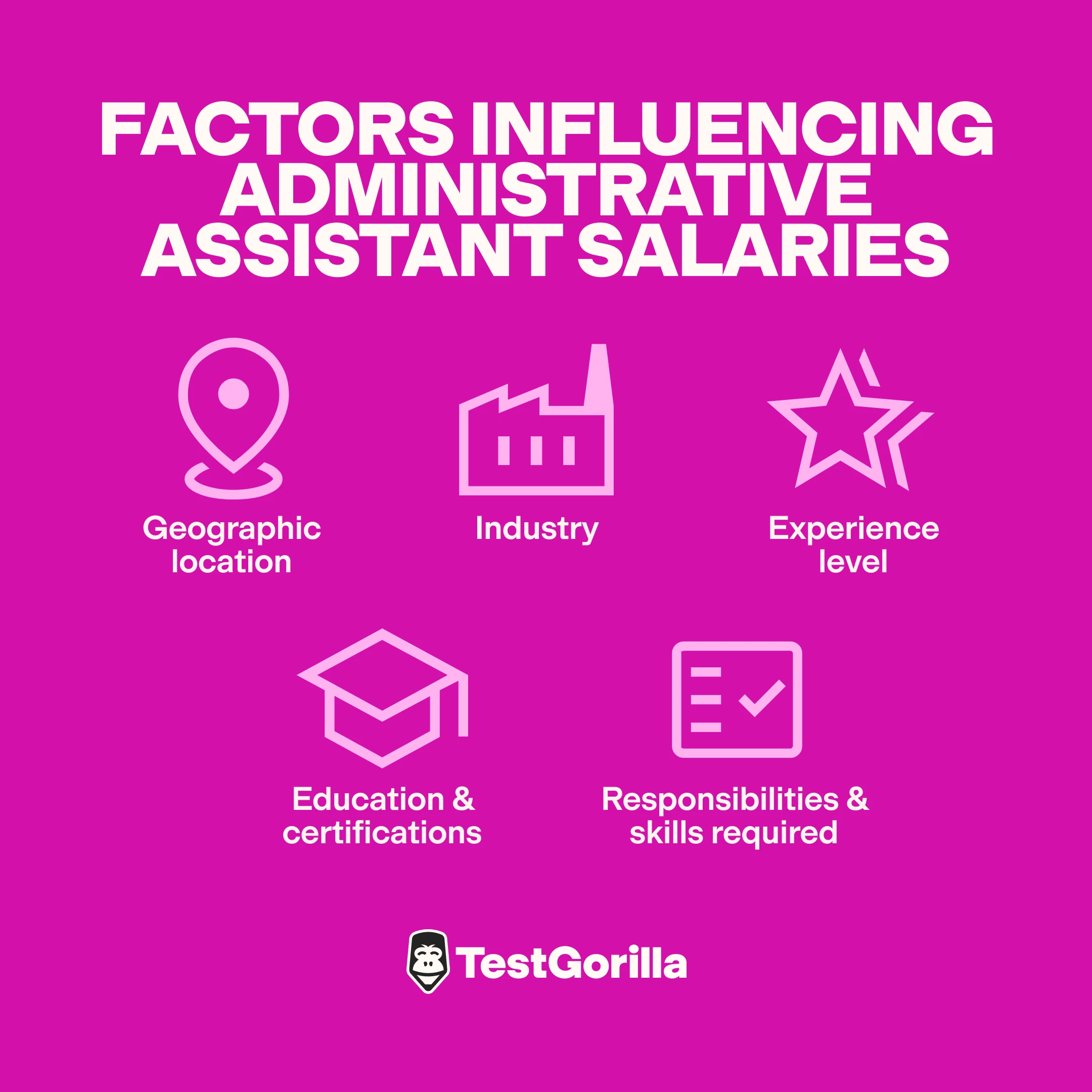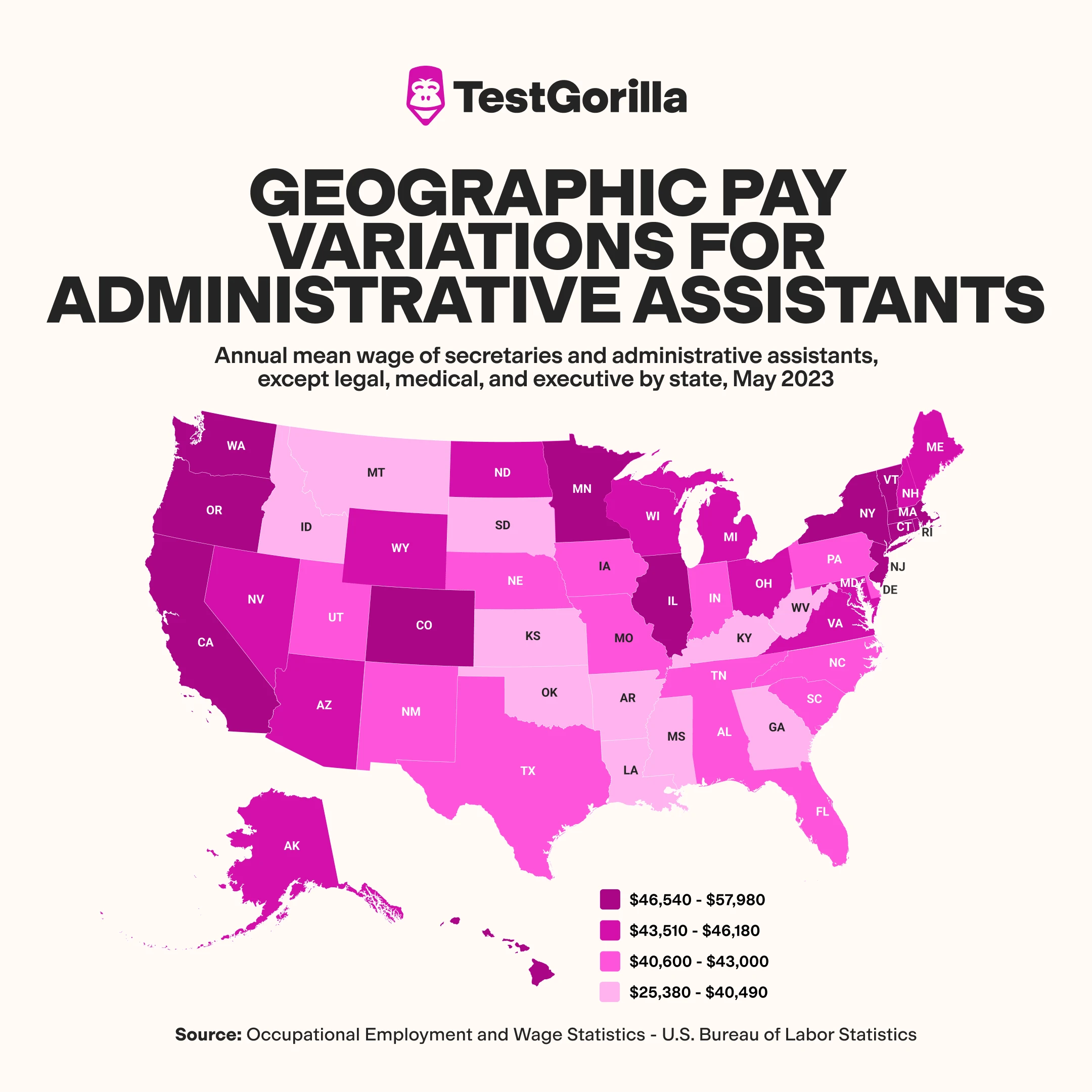Administrative assistants are the glue that holds your office together, ensuring everything runs smoothly behind the scenes. They play an indispensable role, and their salary needs to reflect that.
Fair compensation not only shows that you value hard work, but it also helps retain top talent. If you’re unsure where your compensation should fall, don’t worry – we’ve got you covered.
Our comprehensive guide explores what to pay an administrative assistant, considering factors like geographical location, industry, and how experience impacts remuneration. We also look at what benefits you can offer beyond salary.
How we researched this topic
Deciding what to pay an administrative assistant is no easy feat. That’s why we’ve trawled the latest government salary data from the U.S. Bureau of Labor Statistics (BLS) to give you the most up-to-date, reliable picture of what fair compensation looks like.
This data covers mean vs. median salary, how geography impacts pay, which sectors fetch the highest paycheck, and more. This way, you can be confident you’re making fair, measured, and data-driven decisions about compensation.
Key takeaways
In the US, administrative assistants make a median salary of $44,280. Top earners can make over $62,340, while lower earners can expect to make $30,280.
Geography, experience, and industry are the most important factors determining administrative assistant pay.
The District of Columbia and Connecticut offer the highest hourly salaries for administrative assistants, while Kentucky, Louisiana, and Kansas are among those that provide the lowest.
Administrative assistants for the US Postal Service and those in petroleum manufacturing tend to earn the highest salaries, while those involved in leather processing and knitting mills earn the least.
The best insights on HR and recruitment, delivered to your inbox.
Biweekly updates. No spam. Unsubscribe any time.
National salary statistics for administrative assistants
Want to know what to pay an administrative assistant? Take a data-driven approach! Check out the latest data from the BLS survey below.
Wage category | Annual wage | Hourly wage |
Median wage | $44,280 | $21.29 |
Mean wage | $45,490 | $21.87 |
Top 10% wage earners | $62,340 | $29.97 |
Bottom 10% wage earners | $30,280 | $14.56 |
Median salary vs. mean salary
The mean salary is the average of all administrative assistant salaries. The median is the middle data point. For example, if we only had three data points: $18, $27, and $35 per hour, the median would be $27, and the average (mean) would be $26.33.
The difficulty with the mean data point is that really high or low salaries can skew it. If there’s one admin assistant making way above or below the rest, it’ll pull the average up or down.
The median, in the middle of all the data points, gives us a clearer sense of the “typical” pay. This is especially useful when there is a wide range of salaries or if a number of high or low earners skew the average.
Factors influencing salaries
The pay of an administrative assistant can be significantly impacted by:
Geographic location. Cost of living and location can have a big impact on salary. High-cost-of-living areas like New York, Texas, and California will have higher rent prices, grocery costs, and general expenses. As a result, administrative assistants working in these regions generally earn more.
Industry. Industries turning greater profits, requiring more complex skill sets, or with roles that are more in demand often have a higher salary benchmark.
Experience level. Experienced administrative assistants can generally fetch a higher salary than their less experienced counterparts due to their skills, knowledge, and proven track record.
Education and certifications. Having additional credentials, such as certifications in project management, advanced computer software, or specialized office skills, shows that a candidate is serious about their career and capable of handling more responsibilities. As a result, highly qualified candidates can often command higher salaries.
Responsibilities and skills required. The more skills a candidate can bring to the table, the more they should be paid. Equally, the more complex the duties and the bigger the ask within a role, the higher the salary tends to be.
We’ll look at each of these factors in more detail below.
Geographic pay variations
Check out this state-by-state breakdown of what administrative assistants are paid.
Top paying states:
State | Hourly mean wage | Annual mean wage |
District of Columbia | $27.88 | $57,980 |
Connecticut | $26.72 | $55,570 |
Massachusetts | $26.33 | $54,770 |
California | $25.79 | $53,630 |
Washington | $25.72 | $53,490 |
Other top-paying states (ranging from $46,540 to $57,980) include:
Oregon
Colorado
Minnesota
Illinois
New York
Vermont
Rhode Island
New Jersey
From this data, we can see that states with a higher cost of living tend to pay employees more. For instance, the District of Columbia and Connecticut top the list at $57,980 and $55,570, respectively.
This reflects the pricier urban areas where rent, groceries, and just about everything else is higher. For example, did you know the average cost to rent an apartment in Washington, DC, is $2,281 per month?
On the flip side, the states with the lowest pay for administrative assistants (ranging from $25,380 to $40,490) include:
Idaho
Montana
South Dakota
Kansas
Oklahoma
Arizona
Louisiana
Mississippi
Georgia
Kentucky
West Virginia
Although these states offer lower wages, the overall cost of living is often much more manageable. For example, the average apartment in Louisiana costs $1,041 per month to rent.
Industry-specific pay data
Administrative assistants in high-profit industries or those requiring specialized skills can often command higher salaries.
Industry | Hourly mean wage | Annual mean wage |
Postal Service (Federal Government) | $33.45 | $69,580 |
Telecommunications | $30.31 | $63,040 |
Petroleum and Coal Products Manufacturing | $29.80 | $61,990 |
Pipeline Transportation of Crude Oil | $29.23 | $60,800 |
Pharmaceutical and Medicine Manufacturing | $29.22 | $60,780 |
Conversely, the lowest-paying industries are as follows:
Industry | Hourly mean wage | Annual mean wage |
Leather and Hide Tanning and Finishing | $16.04 | $33,350 |
Radio Broadcasting Stations | $17.11 | $35,590 |
Scenic and Sightseeing Transportation, Land | $17.34 | $36,060 |
Offices of Chiropractors | $17.50 | $36,390 |
Leather and Allied Product Manufacturing | $17.97 | $37,370 |
Apparel Knitting Mills | $18.01 | $37,470 |
Automotive Parts, Accessories, and Tire Retailers | $18.05 | $37,530 |
Key findings:
Highest-paying industries: The US Postal Service and the telecommunications sector offer the highest pay for administrative assistants, with mean salaries of $69,580 and $63,040, respectively.
Lowest-paying industries: Radio broadcasting and leather and hide tanning pay administrative assistants the lowest, with mean salaries of $35,590 and $33,350, respectively.
Why the salary differences?
There are a lot of factors that go into why salaries differ so widely for administrative assistants across industries. These include:
Industry profits and budgets. Companies with strong profit margins, like telecommunications and petroleum manufacturing, often have the capital to offer higher salaries upfront. As a result, these industries are more willing to pay top dollar for administrative assistants.
Risk associated with roles. Administrative assistants in transportation, legal, and medical settings often face greater responsibilities and more complex tasks than those in more straightforward office environments. These roles may require specialized knowledge, quick decision-making skills, or working with confidential information. Because of this, salaries in these areas tend to be higher.
Competition. Telecommunications, the US Postal Service, and petroleum industries are considered secure and lucrative, with many highly qualified candidates vying for limited positions, which pushes the salary up.
Pay by experience, education, and skills
Unfortunately, the BLS doesn’t publish any data on how experience impacts the pay of an administrative assistant. However, other sources provide guides on salary expectations compared to tenure. This is what we discovered:
0-2 years experience: $42,000 - $63,000
2-4 years experience: $47,000 - $66,000
5-7 years experience: $48,000 - $73,000
While there isn’t a technical qualification candidates can gain that warrants offering a higher salary, they will need a minimum of a High School Diploma or General Education Diploma (GED) to succeed. More qualified candidates may find it easier to stand out among the crowd, making them likely to land better-paid roles.
For instance, the following courses or certifications may command higher pay for administrative assistants:
Business administration
Bookkeeping
Data processing
Specific law courses
Medical writing
Did you know: Almost 40% of people working as administrative assistants have earned a bachelor's degree?
Benefits beyond salary
We all go to work because we want to be paid, right?
But what if we told you that a high salary may not be the key to a happy workforce? A recent study has shown that a $10,000 pay rise only equates to a 1% increase in happiness. Instead, career opportunities, work-life balance, and other benefits have a much bigger impact on employee satisfaction.
As a result, you may want to offer your administrative assistants the following benefits:
Paid Time Off (PTO). PTO is key to ensuring a healthy work-life balance for your administrative assistants. Vacation leave, sick pay, and personal days allow employees to spend time with their families, rest when they need to, and recharge so they can bring their best selves to work.
Remote working. Administrative assistants can complete most of their work on a computer or laptop, making them ideal candidates for remote or hybrid work setups. Giving them the flexibility to work from home or mixing home and office days can boost morale, reduce commuting stress, and help them manage personal responsibilities more easily.
Health and dental insurance. Did you know that around 72% of medical care benefits are provided by private-sector employers? Access to routine checkups, emergencies, and dental care can help retain good workers.
Retirement plans. Retirement savings plans like 401(k)s or Roth IRAs can be fantastic incentives for administrative assistants who want to prepare for their futures and meet long-term savings goals.
Parental and family leave. Planning for the future also includes parental leave through paternity, maternity, adoption, and fertility leave. Allowing employees time to bond with a new child or attend to family matters without stressing about work boosts loyalty and engagement, resulting in happier, more focused team members when they’re back. Plus, cute baby pictures!
Pro tip: The benefits offered should be listed separately from financial compensation from the employee’s perspective but should be considered as part of the total cost from your perspective.
Level up your hiring process with talent assessments
Administrative assistants are key players in the corporate game, and the caliber of your candidates can make or break office operations. As a result, you’ll need to pay them fairly for their skills and experience, ensuring they feel valued and motivated to give their best.
Administrative assistant pay can vary greatly based on location, industry, experience, and skills. However, short courses and certifications in data literacy, business administration, and bookkeeping can boost salaries.
To find the best administrative assistant for your company, consider using a skills-based approach to zero in on candidates with the skills and qualifications specific to your open role.
TestGorilla’s talent assessment platform can help you measure your administrative assistant candidate’s fit for the job. And, with over 350+ tests in our test library, you can create custom assessments to measure the exact skills and competencies you need.
Level up your remote hiring process with TestGorilla. Sign up for your free trial or demo today.
FAQs
Is it worth being an administrative assistant?
Being an administrative assistant can be interesting and rewarding if you enjoy organizing, managing details, and supporting a team.
How much are administrative assistants paid?
Administrative assistants are paid between $33,350 and $69,580 depending on their industry, experience, skill set, and location.
You've scrolled this far
Why not try TestGorilla for free, and see what happens when you put skills first.




















